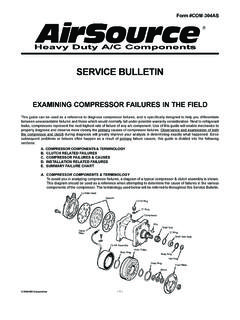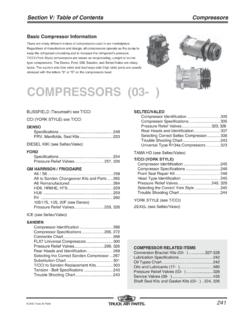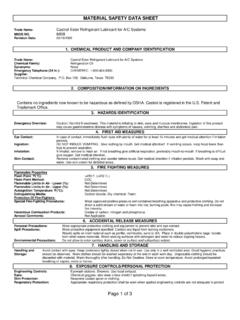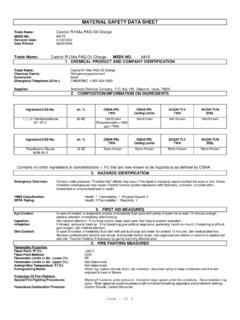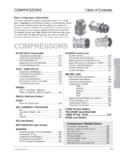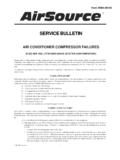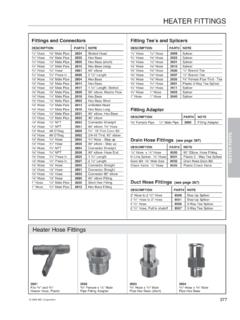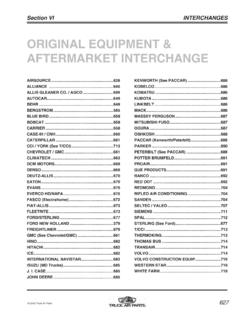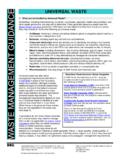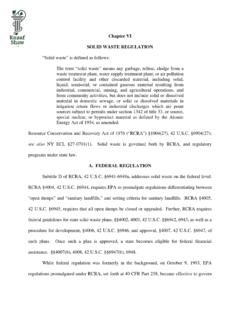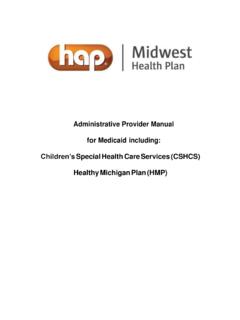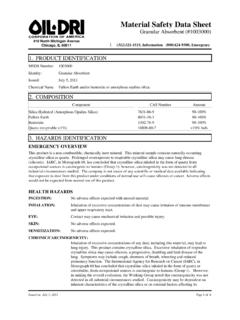Transcription of JOHNSEN'S PREMIUM PAG 46 32 FL.OZ. - MEI …
1 JOHNSEN'S PREMIUM pag 46 32 Safety Data Sheet according to Federal Register / Vol. 77, No. 58 / Monday, March 26, 2012 / Rules and Regulations Revision date: 09/19/2014 : Version: 05/11/2014 EN (English US) 1/6 SECTION 1: Identification of the substance/mixture and of the company/undertaking Product identifier Product form : Substance Trade name : JOHNSEN'S PREMIUM pag 46 32 CAS No : Proprietary Product code : 6813-6 Relevant identified uses of the substance or mixture and uses advised against Use of the substance/mixture : Lubricant Details of the supplier of the safety data sheet Technical Chemical Company BOX 139 Cleburne, Texas 76033 T 817-645-6088 Emergency telephone number Emergency number : CHEMTREC 24 Hour 1-800-424-9300, 1-703-527-3887 (International) SECTION 2: Hazards identification Classification of the substance or mixture Classification (GHS-US) Acute Tox. 4 (Oral) H302 Full text of H-phrases: see section 16 Label elements GHS-US labeling Hazard pictograms (GHS-US) : GHS07 Signal word (GHS-US) : Warning Hazard statements (GHS-US) : H302 - Harmful if swallowed Precautionary statements (GHS-US) : P264 - Wash affected areas thoroughly after handling P270 - Do not eat, drink or smoke when using this product P301+P312 - If swallowed: Call a poison center, doctor if you feel unwell P330 - Rinse mouth P501 - Dispose of contents/container to appropriate waste disposal facility, in accordance with local, regional, national, international regulations.
2 Other hazards Other hazards not contributing to the classification : None under normal conditions. Unknown acute toxicity (GHS-US) No data available SECTION 3: Composition/information on ingredients Substance Name : Polyalkylene Glycol Alkyl Ether 46 CAS No : Proprietary Name Product identifier % Classification (GHS-US) Polyalkylene Glycol Alkyl Ether 46 (Main constituent) (CAS No) Proprietary 100 Acute Tox. 4 (Oral), H302 Full text of H-phrases: see section 16 Mixture Not applicable JOHNSEN'S PREMIUM pag 46 32 Safety Data Sheet according to Federal Register / Vol. 77, No. 58 / Monday, March 26, 2012 / Rules and Regulations 05/11/2014 EN (English US) 2/6 SECTION 4: First aid measures Description of first aid measures First-aid measures general : Never give anything by mouth to an unconscious person. If you feel unwell, seek medical advice (show the label where possible). First-aid measures after inhalation : Assure fresh air breathing.
3 Allow the victim to rest. First-aid measures after skin contact : Remove affected clothing and wash all exposed skin area with mild soap and water, followed by warm water rinse. First-aid measures after eye contact : Rinse immediately with plenty of water. Obtain medical attention if pain, blinking or redness persist. First-aid measures after ingestion : Rinse mouth. Do NOT induce vomiting. Obtain emergency medical attention. Call a POISON CENTER/doctor/physician if you feel unwell. Most important symptoms and effects, both acute and delayed Symptoms/injuries : If you feel unwell, seek medical advice. Symptoms/injuries after inhalation : May cause respiratory irritation. Symptoms/injuries after skin contact : May cause slight irritation . Itching. Red skin. Symptoms/injuries after eye contact : May cause slight eye irritation . Inflammation/damage of the eye tissue. Redness of the eye tissue. Symptoms/injuries after ingestion : Swallowing a small quantity of this material will result in serious health hazard.
4 Indication of any immediate medical attention and special treatment needed No additional information available SECTION 5: Firefighting measures Extinguishing media Suitable extinguishing media : Foam. Dry powder. Carbon dioxide. Water spray. Sand. Unsuitable extinguishing media : Do not use a heavy water stream. Special hazards arising from the substance or mixture No additional information available Advice for firefighters Firefighting instructions : Use water spray or fog for cooling exposed containers. Exercise caution when fighting any chemical fire. Prevent fire-fighting water from entering environment. Protection during firefighting : Do not enter fire area without proper protective equipment, including respiratory protection. SECTION 6: Accidental release measures Personal precautions, protective equipment and emergency procedures General measures : Remove ignition sources. For non-emergency personnel Protective equipment : Gloves.
5 Safety glasses. Emergency procedures : Evacuate unnecessary personnel. For emergency responders Protective equipment : Equip cleanup crew with proper protection. Emergency procedures : Ventilate area. Environmental precautions Prevent entry to sewers and public waters. Notify authorities if liquid enters sewers or public waters. Methods and material for containment and cleaning up For containment : Dam up the liquid spill. Plug the leak, cut off the supply. Contain released substance, pump into suitable containers. Methods for cleaning up : Soak up spills with inert solids, such as clay or diatomaceous earth as soon as possible. Collect spillage. Store away from other materials. Reference to other sections See Heading 8. Exposure controls and personal protection. SECTION 7: Handling and storage Precautions for safe handling Precautions for safe handling : Wash hands and other exposed areas with mild soap and water before eating, drinking or smoking and when leaving work.
6 Provide good ventilation in process area to prevent formation of vapor. Hygiene measures : Do not eat, drink or smoke when using this product. Wash affected areas thoroughly after handling. Wash contaminated clothing before reuse. Wash hands and other exposed areas with mild soap and water before eating, drinking or smoking and when leaving work. JOHNSEN'S PREMIUM pag 46 32 Safety Data Sheet according to Federal Register / Vol. 77, No. 58 / Monday, March 26, 2012 / Rules and Regulations 05/11/2014 EN (English US) 3/6 Conditions for safe storage, including any incompatibilities Technical measures : Proper grounding procedures to avoid static electricity should be followed. Comply with applicable regulations. Storage conditions : Keep only in the original container in a cool, well ventilated place away from : Keep container closed when not in use. Incompatible products : Strong bases. Strong acids. Incompatible materials : Sources of ignition. Direct sunlight.
7 Specific end use(s) Follow Label Directions. SECTION 8: Exposure controls/personal protection Control parameters Exposure controls Appropriate engineering controls : Local exhaust venilation, vent hoods. Personal protective equipment : Gloves. Safety glasses. Avoid all unnecessary exposure. Hand protection : Wear protective gloves. Eye protection : Chemical goggles or safety glasses. Skin and body protection : Wear suitable protective clothing. Respiratory protection : Wear appropriate mask. Other information : Do not eat, drink or smoke during use. SECTION 9: Physical and chemical properties Information on basic physical and chemical properties Physical state : Liquid Appearance : Liquid. Color : Colourless to yellow. Odor : Characteristic. Mild. Odor threshold : No data available pH : No data available Relative evaporation rate (butyl acetate=1) : No data available Melting point : No data available Freezing point : No data available Boiling point : Decomposes before boiling Flash point : > 190 C Auto-ignition temperature : No data available Decomposition temperature : No data available Flammability (solid, gas) : No data available Vapor pressure : No data available Relative vapor density at 20 C : No data available Relative density : 1 @ 20 deg C Solubility : Moderately soluble in water.
8 Log Pow : No data available Log Kow : No data available Viscosity, kinematic : 45 mm /s @ 40 deg C Viscosity, dynamic : No data available Explosive properties : No data available Oxidizing properties : No data available Explosive limits : No data available Other information VOC content : 0 % JOHNSEN'S PREMIUM pag 46 32 Safety Data Sheet according to Federal Register / Vol. 77, No. 58 / Monday, March 26, 2012 / Rules and Regulations 05/11/2014 EN (English US) 4/6 SECTION 10: Stability and reactivity Reactivity No additional information available Chemical stability Not established. Possibility of hazardous reactions Not established. Conditions to avoid Direct sunlight. Extremely high or low temperatures. Incompatible materials Strong acids. Strong bases. Hazardous decomposition products Toxic fume.. Carbon monoxide. Carbon dioxide. SECTION 11: Toxicological information Information on toxicological effects Acute toxicity : Harmful if swallowed.
9 JOHNSEN'S PREMIUM pag 46 32 ( \f )Proprietary LD50 oral rat 500 mg/kg Skin corrosion/irritation : Not classified Serious eye damage/irritation : Not classified Respiratory or skin sensitization : Not classified Germ cell mutagenicity : Not classified Carcinogenicity : Not classified Reproductive toxicity : Not classified Specific target organ toxicity (single exposure) : Not classified Specific target organ toxicity (repeated exposure) : Not classified Aspiration hazard : Not classified Potential Adverse human health effects and symptoms : Based on available data, the classification criteria are not met. Harmful if swallowed. Symptoms/injuries after inhalation : May cause respiratory irritation. Symptoms/injuries after skin contact : May cause slight irritation . Itching. Red skin. Symptoms/injuries after eye contact : May cause slight eye irritation . Inflammation/damage of the eye tissue. Redness of the eye tissue. Symptoms/injuries after ingestion : Swallowing a small quantity of this material will result in serious health hazard.
10 SECTION 12: Ecological information Toxicity No additional information available Persistence and degradability JOHNSEN'S PREMIUM pag 46 32 (Proprietary) Persistence and degradability Not established. Bioaccumulative potential JOHNSEN'S PREMIUM pag 46 32 (Proprietary) Bioaccumulative potential Not established. Mobility in soil No additional information available Other adverse effects Other information : Avoid release to the environment. JOHNSEN'S PREMIUM pag 46 32 Safety Data Sheet according to Federal Register / Vol. 77, No. 58 / Monday, March 26, 2012 / Rules and Regulations 05/11/2014 EN (English US) 5/6 SECTION 13: Disposal considerations Waste treatment methods Waste disposal recommendations : Dispose in a safe manner in accordance with local/national regulations. Dispose of contents/container to appropriate waste disposal facility, in accordance with local, regional, national, international regulations. Ecology - waste materials : Avoid release to the environment.

